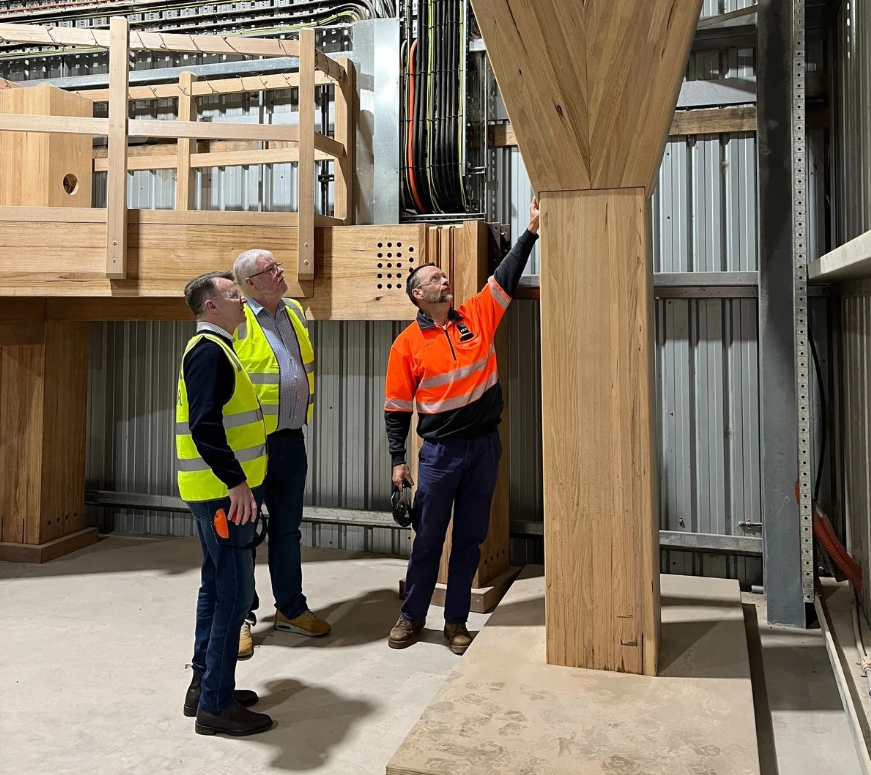Dr Chris Lafferty retires from his role as head of Research, Development and Extension (RD&E) this month after 23 years with Forest & Wood Products Australia (FWPA).
This significant transition offers a chance to reflect on the changes he’s experienced both within the organisation and across the industry in his two decades in the role.
His time spans major changes, including FWPA’s shift from a government agency to a privatised entity in 2007.
“Previously, the Board was appointed by the Minister, selected from candidates identified (in consultation with industry associations) by a person known as the ‘presiding member’. Now, FWPA Board members are directly elected by the members from candidates identified by a Director Selection Committee led by an FWPA Director and representatives from industry peak bodies,” he explains.
“It’s brought us much closer to our members and increased our focus on reflecting funding initiatives designed to address their collective needs.”
One constant throughout FWPA’s changes, however, has been the strength of its people.
“In my time I’ve worked with three CEOs, four chairs and 35 directors,” he says.
“At each time they’ve represented the best of contemporary industry leadership, reflected changing trends and made clear, considered decisions from a position of broad experiences and specific sets of skills across research, marketing, governance, and market understanding. They’ve been generous with their time and support, and I’ve learnt a lot from working with each of them.”
“Over the same period, I have worked with 47 colleagues and numerous contractors, and researchers. The organisation has been fortunate to be able to recruit professionals with specialised skill sets to design and deliver a wide range of programs and services to our industry and Government stakeholders.
Additionally, countless numbers of researchers across a broad range of disciplines have added greatly to FWPA programs as well as to my own knowledge and professional development.
A particular privilege has been the opportunity to collaborate with three of Australia’s Marcus Wallenberg Prize Awardees: Bob Leicester, the acknowledged father of timber durability prediction, who retired from CSIRO the year before I joined the then FWPRDC yet is still active in timber research to this day; Rob Evans and his diligent development and ongoing refinement of the Silviscan instrument at CSIRO; and Nicholas Coops during his early days of remote sensing research at CSIRO with the Echidna instrument. Each of them rightfully acknowledged as international leaders in their fields of research and significant contributors to FWPA funded research.”
The Power of Collaboration
For Chris, collaboration remains FWPA’s core strength.
“We don’t ‘do’ much, but we facilitate a lot,” he jokes.
He goes on to explain. “The unique model of the Australian research and development corporations that combine industry with Australian Government matched funding lets RDCs such as FWPA empower some really creative people to work with industry stakeholders that want to engage to the next level collectively.”
“The idea of a compulsory levy paid by all and matched by the government is a fantastic model to address the longer-term issues.”
Chris also credits the broader RDC network. “We R&D Managers meet twice a year as a group to share ideas, practices, and to align our work. RDCs are uniquely impactful because they bring research together with industry supporters at a program rather than project level and avoid traditional ‘piecemeal’ approaches and outcomes.”

Research Requires Risk and Innovation
Chris can point to countless highlights of RD&E projects over his time at FWPA, but the common thread is the connection between research and innovation.
Chris sees risk as central to research. RDCs such as FWPA are uniquely positioned to take on that risk and build knowledge through the longevity of their research programs and funding support.
“The real strength however lies in the research archive,” he says.
“What they can use to power innovation is the work we’ve completed, because it’s been developed on that same protocol of participation and collaboration.
“Some of the earliest work on drying of timber still stands out; everyone has benefited in that area and there’s more value and yield to be accessed now through new technology. The rapid deployment of continuous kiln systems throughout the softwood industry is evidence of that additional value capture through substantially reduced energy consumption in the overall drying process.”
To that point, Chris explains research is most successful when the knowledge gained is tested and applied in practice through the life of the research project, so companies can use that insight to drive and guide the development of new tools, techniques and approaches.
“There’s a great quote—not my own—that research is turning money into knowledge, and innovation is turning knowledge into money.
“We need companies to commit to innovation. It’s really in the hands of the corporations, but we can prime that pipeline by delivering the knowledge and data.
“We can’t keep researchers away in a lab: get them into the mill, get them into the plantations and processing sites with real-time input and feedback from the industry. Then you get outcomes that are focused on what people actually want and can use.”
Chris’ RD&E Highlights
In Chris’ 23 years, FWPA has invested more than $280 million across all of its programs and services. This sum increases to well over $400 million accounting for other industry and researcher collaborations such as ARC centres, CRCs and a number of very impactful jointly funded international programs, especially with New Zealand.
Many highlights reflect real-world challenges addressed through industry testing and application.
A CSIRO-led project, headed by Dr Voytek Gutowski, set out to make timber products such as window frames and other external features powder-coatable like metals, improving its appeal in construction.
“In high-rise construction, timber isn’t favoured for external use due to ongoing maintenance and protection issues,” Chris explains.
Developed with CSIRO and collaborators from the University of Melbourne and Swinburne University, and trialled by Australian Sustainable Hardwoods (ASH), the process used a ‘purpose designed liquid’ to apply a surface electric charge to wood, allowing powder coating. The spray also showed potential for strengthening adhesive systems through enhanced bonding and providing stable UV-resistant clear coats.
Results were strong. “The best data we have to compare paint and coating performance is from the American automotive paint standards,” says Chris. “We replicated 20 years of Southern USA climate on a car bonnet, achieving similar durability against moisture, heat, UV, shrinking and cracking.”
While not widely adopted, Chris remains encouraged by the “transformational science” and future product potential.
Other highlights include Resistograph technology, which assesses tree quality mid-rotation, helping improve management decisions. More than 30 units are currently in use industry-wide across Australia softwood plantations.
Tangible industry benefits are also clear in areas such as biosecurity, with the development of control programs to address pests such as the Monterey pine aphid (Diaeretus essigellae).
“By 2004, the green triangle region was experiencing decreased growth rates that led to around $20 million in lost fibre value each year,” says Chris.
“FWPA-funded research identified and introduced a wasp species to control the aphid population.”
Future-Proofing Timber Through Data, Genetics and Durability Research
Long-term performance is key to maintaining market confidence, and for Chris, the establishment of the National Centre for Timber Durability and Design Life (NCTDDL) has been a major milestone.
“If the market loses confidence that timber is fit for purpose and can provide an adequate service life, we’re in big trouble,” he states.
“Durability work is long-term and must stay engaged with new ideas and the wider community.”
Australia’s harsh climate once made it a world leader in timber durability, and Chris sees the NCTDDL helping reclaim that position.
Chris also sees genetics research as a critical area for long-term improvement within the industry.
Genetics also offers huge potential.
“Australia’s trees are relatively unimproved compared other agricultural products such as wheat or cattle, which have seen centuries of optimisation,” he says. “There’s enormous opportunity ahead.
“But the challenge is rotation age and external factors — even with a perfect genome, a tree must survive 30 years of drought, fire, pests, disease and nutritional changes.”
Unlike agriculture, where gains can be realised quickly, forestry requires long-term vision — something FWPA is uniquely positioned to provide without the same commercial pressures facing individual members.
FWPA’s wealth of industry data will also continue to support members.
“When I first arrived, the office had dozens of filing cabinets full of documents being continually accessed for the administration of our research projects— the sign of a successful office at the time!” he jokes.
All of that same information is now digitised and maintained through online file servers
“Big data systems have now been renamed AI, but the principle’s the same: storing and converting information into insights industry can use.”
Chris’ Changing Role at FWPA
Though retiring as Head of RD&E, Chris remains with FWPA as Company Secretary, continuing to share his experience.
Ian Blanden has stepped in as Head of RD&E, with Chris noting Ian is “taking to the role like a duck to water.”
As far as what he’ll miss most about the role, Chris says it will be “the engagement with the industry and the research community, being the bridge between them.”
He will also miss the daily opportunity to work alongside some “really generous and helpful people” and extends his gratitude to the entire FWPA team and leadership, with “particular recognition to our program managers, especially Jarrod Gooden for his tireless work in maintaining the FWPA project portfolio.”
Chris officially concludes his RD&E role today, June 30, 2025.



